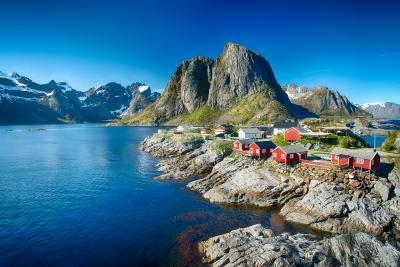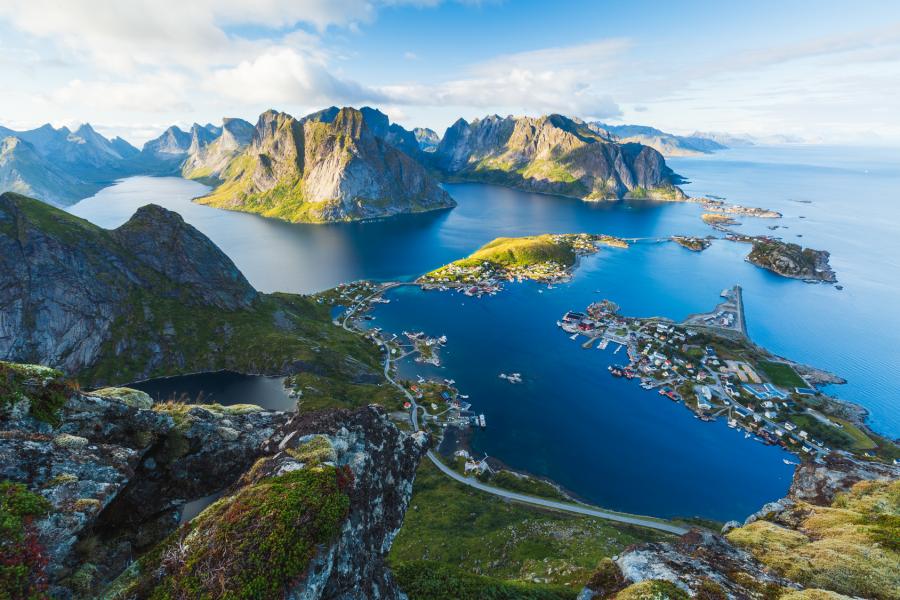Not only in winter, when the northern lights hang like garlands over the white landscape, the Lofoten Islands in northern Norway are a worthwhile vacation destination. Summer, when the rain stops for a few months and the low vegetation blossoms into delicate colors against the gray of the mountains, is the best time to explore the islands' picturesque mountain and coastal scenery by boat, bicycle or on hiking tours. Especially nature lovers and outdoor enthusiasts will have their pleasure in this varied region.
Climate: temperateä&aerospace;igt with temperatures between 10 and 20 degrees
Sailing season: June to August
Yacht charter Lofoten
South of Tromsø lies the most famous island paradise of Norway: Lofoten. Here 80 islands line up, which run from the mainland into the European North Sea. Between them and the mainland lies the Vestfjord, where our base is located. We set off from the largest town in Lofoten, Svolvær on the south coast of Austvågøya Island. Caution is advised when navigating in the island areas of Norway. There can be strong water eddies and currents between the islands, as water from the European North Sea pushes through here. Well known is the Moskenstraumen, also called the Maelstrom, between the islands Moskenesøy and Værøy. In the fjords, sailing is more sheltered from strong winds and the coast slopes more steeply.
In the footsteps of the Vikings, breathtaking island landscapes and majestic sea eagles on a yacht charter Lofoten
 In the months of June to August it rains less and the weather is good for hiking and outdoor activities. Due to the Gulf Stream, temperatures are comparatively milder than in other places at the same altitude. Nevertheless, even in summer, it is advisable to have warm clothes as well. While in winter the chances of experiencing the Northern Lights in Lofoten are very good, in summer the midnight sun is a constant companion. The range of light conditions bathes the landscape in very different moods.
In the months of June to August it rains less and the weather is good for hiking and outdoor activities. Due to the Gulf Stream, temperatures are comparatively milder than in other places at the same altitude. Nevertheless, even in summer, it is advisable to have warm clothes as well. While in winter the chances of experiencing the Northern Lights in Lofoten are very good, in summer the midnight sun is a constant companion. The range of light conditions bathes the landscape in very different moods.
The islands rise out of the sea as high mountains, which can reach over 1000 meters above the water level. Steep cliffs characterize the coast. From time to time there are also bays with beaches, which with their white color and turquoise water can sometimes remind you of the South Seas. The islands can be easily explored by hiking or biking. You will be rewarded with great views over the island landscape.
The inhabitants of the islands live besides tourism from fishing, so it is clear who is the star on the plate in the local restaurants. The cultural landscape also includes the hanging stockfish parades in front of the red houses, which is exported from here to other European countries. Herring is also commonly fished.
There have been permanent settlements and farming in Lofoten since the Viking Age. In Borg on the island of Vestvågøy, archaeologists discovered the largest longhouse from the Viking Age to date, and a museum has developed around it that gives you an understanding of life in this period, as well as exhibiting finds and reconstructed ships. The nearest island, Grimsøy, is smaller and flatter in landscape than the others. Here, the landscape is dominated by bogs, where peat was mined in the past. Today the island is a nature reserve. On the north side of Austvågøya, where our base is, there is an aurora center in Laukvik, where you can learn more about the northern lights, which can be seen especially well here in autumn and winter in Lofoten. On the largest island of Lofoten there are fishing villages, some of them very old, like Kabelvåg and Henningsvaer. In Trollfjord, a rather narrow fjord, nature surrounds you in the form of mountains rising steeply from the water. Above this majestic landscape you may also see a sea eagle gliding, which is at home here. In Trollfjord you will also pass one of the highest mountains in Lofoten, Trolltindan. Another giant you may encounter here is a Hurtigruten ship, which navigates the fjord as a point of interest for its passengers.
On the island of Moskenesøy at the western end of Lofoten lies Reine. Also situated between steeply rising mountains, the fishing village always forms the typical postcard scenery that one associates with the Lofoten Islands. A visit to the village can also be combined with a hike on the Reinebringen. For those who not only want to eat the famous stockfish but also learn more about its history and production, the stockfish museum in the town of Å will enlighten you.
The two islands of Værøy and Røst form the end of the North Sea. On the former, most of the just over 700 inhabitants live in the main town of Sørland. The oldest church in Lofoten is located on the island. Røst is a whole archipelago of small islands and skerries. On the main island Røstlandet live a few hundred inhabitants, so there are shopping facilities. They are surpassed by 2.5 million birds, such as puffins, sea eagles, eider ducks and oystercatchers, which are at home here.
To the north, Lofoten is joined by the Vesterålen archipelago, which can also be included in a cruise.

Yacht charter Lofoten - set sail with 1aYachtcharter!

